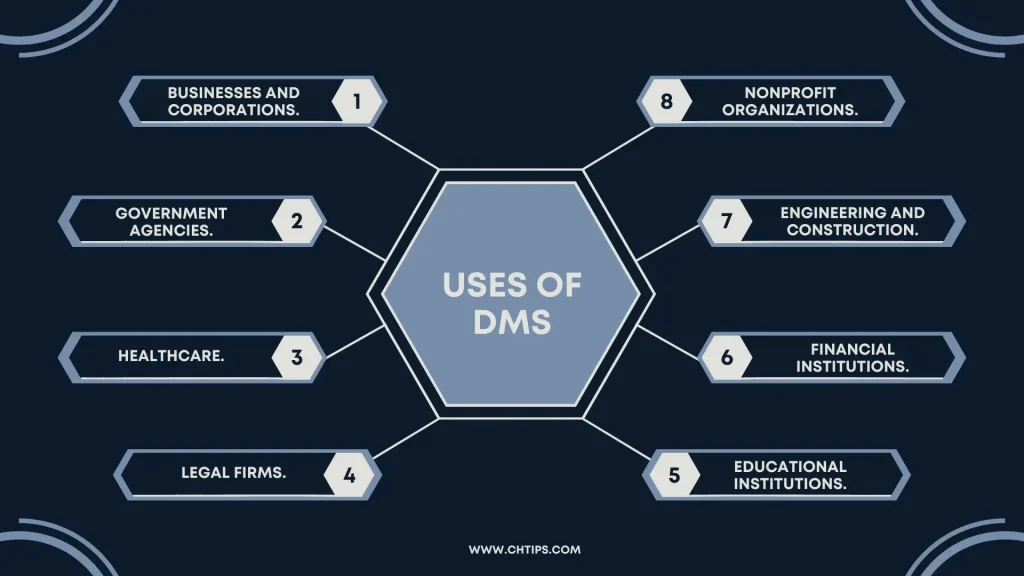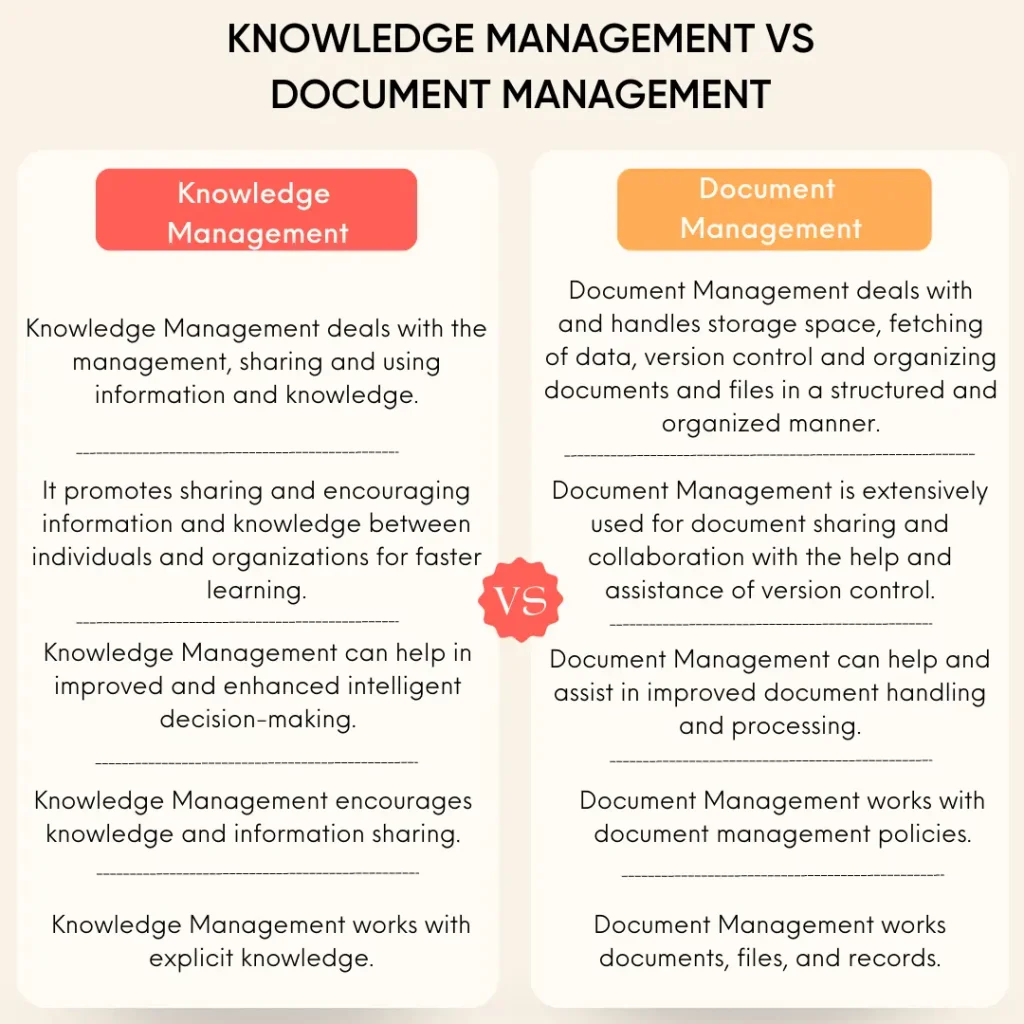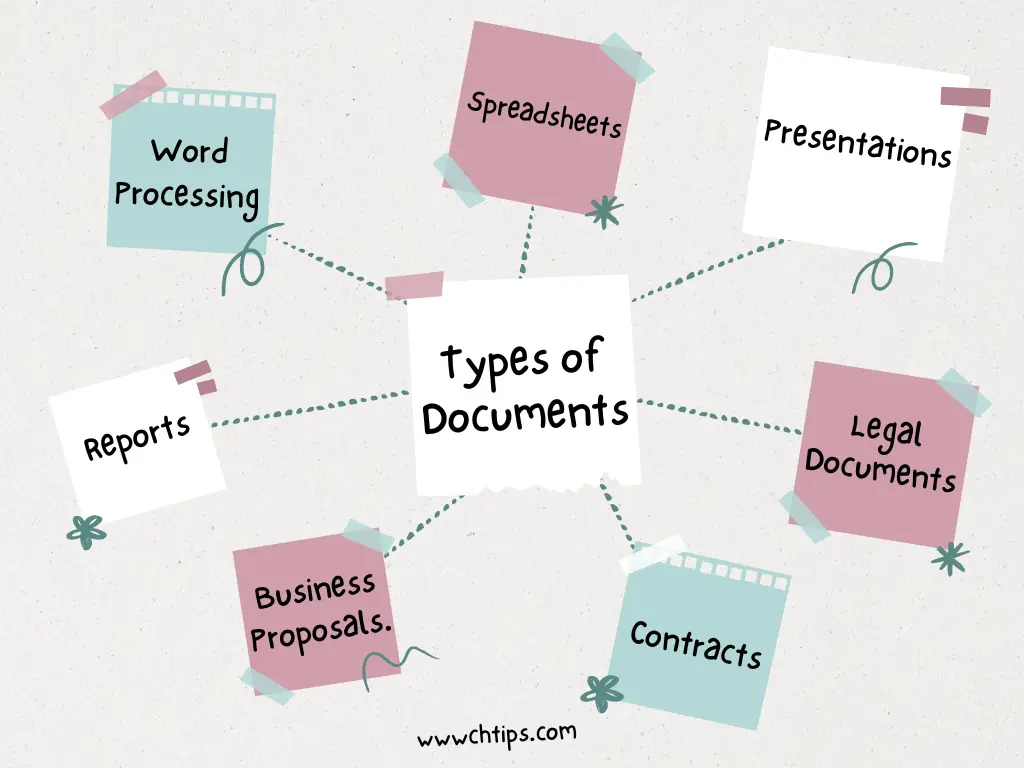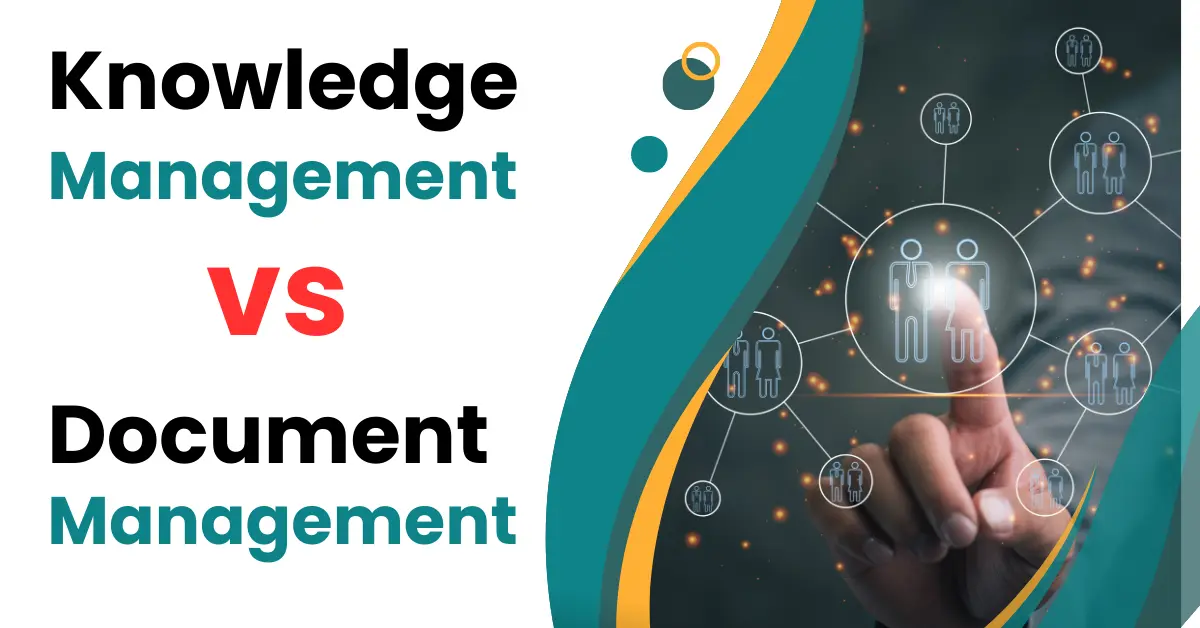Introduction To Knowledge Management vs Document Management
Knowledge Management and Document Management are two fields with significant similarities in business and organization.
Knowledge management primarily captures, stores, and shares information | and data to enhance business and decision-making ability. Knowledge management also adopts a culture of learning and studying.
Document management systematically organizes, stores, retrieves, and controls documents throughout their lifecycle.
In Document management, data and information searching are faster than other systems, using modern techniques like indexing and Metadata.
Knowledge management and document management are involved in information and data sharing, using this information for the betterment of the organization in real-time. Still, there are significant differences between Document Management and Knowledge Management [Knowledge Management vs Document Management].
What is Knowledge Management
Knowledge management is storing, capturing, organizing, sharing and accessing information | knowledge for better performance, usability and decision-making.
There are various activities involved in knowledge management that are.
- Knowledge Creation.
- Knowledge Capture.
- Knowledge Organization.
- Knowledge Storage.
- Knowledge Retrieval.
- Knowledge Sharing and Collaboration.
- Knowledge Transfer.
- Knowledge Measurement and Evaluation.
- Knowledge Application.
- Knowledge Culture.
What is Document Management
Document management is a system that is designed and developed to work for the betterment of business and organization.
Document management is specially used and utilized for data | information storage, version control, and organizing documents and files that are stored in a structured manner for quick retrieval and intelligent decision-making attributes.
The data is searched using features like indexing and Metadata.

A Document Control System typically includes the following features:
- Document Creation.
- Document Versioning and Revision Control.
- Document Approval Workflow.
- Document Storage and Organization.
- Document Retrieval and Search.
- Document Distribution and Access Control.
- Document Audit Trail and Tracking.
- Document Archiving and Retention.
- Security and Permissions.
Knowledge Management vs Document Management | Difference Between Knowledge Management and Data Management
Knowledge Management and Document Management are different types commonly known for using and utilizing knowledge and information inside organizations.
Significant similarities and differences between Knowledge Management and Document Management are included with examples.
| # | Knowledge Management | Document Management |
|---|---|---|
| 1 | Knowledge Management deals with the management, sharing and using information and knowledge. | Document Management deals with and handles storage space, fetching of data, version control and organizing documents and files in a structured and organized manner. |
| 2 | Knowledge Management promotes sharing and encouraging information and knowledge between individuals and organizations for faster learning. | Document Management is extensively used for document sharing and collaboration with the help and assistance of version control. |
| 3 | Knowledge Management can help in improved and enhanced intelligent decision-making. | Document Management can help and assist in improved document handling and processing. |
| 4 | Knowledge Management encourages knowledge and information sharing. | Document Management works with document management policies. |
| 5 | Knowledge Management assists in contextualizing knowledge and promoting learning. | Document Management primarily focuses on predefined attributes and Metadata. |
| 6 | Knowledge Management works with explicit knowledge. | Document Management works documents, files, and records. |
The above mentioned difference between Knowledge Management and Document Management mentions different aspects, views and opinions of information and knowledge inside an organization.
Difference Between Knowledge Management and Data Management

4 Major Types of Knowledge Management?
There are four significant types of knowledge management included below.
- Explicit Knowledge Management.
- Tacit Knowledge Management.
- Internal Knowledge Management.
- External Knowledge Management.
5 Components of Knowledge Management?
There are five standard components of knowledge management.
- Knowledge Creation.
- Knowledge Capture.
- Knowledge Organization.
- Knowledge Storage.
- Knowledge Sharing and Dissemination.
10 Principles of Knowledge Management?
10 commonly recognized principles of knowledge management.
- Explicit Commitment.
- Knowledge-Centric Culture.
- Knowledge Capture and Codification.
- Knowledge Accessibility.
- Knowledge Sharing and Collaboration.
- Continuous Learning.
- Technology Enablement.
- Knowledge Transfer.
- Measurement and Evaluation.
- Continuous Improvement.
5 Benefits and Advantages of Knowledge Management
There are several significant advantages of knowledge management. Some of them are mentioned below.
- Improved Decision-Making.
- Increased Innovation and Creativity.
- Enhanced Efficiency and Productivity.
- Knowledge Retention and Avoidance of Knowledge Loss.
- Improved Customer Service and Satisfaction.
1. Enhanced and Improved Decision-Making.
There is an enhanced and improved decision-making provision when using knowledge management.
They can present authenticated, reliable, intelligent data and information for more beneficial decisions.
There are significant advantages of using knowledge management, such as increasing the quality of decisions, with a better understanding firmly based on intelligent data | information the system provides.
The decision-making can significantly reduce time consumption as well as repetitive errors caused due to insufficient data | information.
2. Increased Innovation and Creativity.
Knowledge management works and deals with enhanced and increased innovations and creativity by using knowledge sharing and working in co-existence.
Organizations can use knowledge to make courageous and intelligent decisions to improve business overall.
The information and knowledge help organizations improve their business with a competitive edge and change market conditions with critical thinking.
3. Enhanced Efficiency and Productivity.
The organized and structured formed knowledge overall enhances efficiency and productivity.
The information can be searched with Metadata and keywords for quick search results, eventually saving time, effort and human errors.
The information and knowledge are easily accessible to employees and team members.
4. Knowledge Retention and Avoidance of Knowledge Loss.
The knowledge and information are captured and stored in a well-mannered and organized system to retrieve them effectively without any human errors.
Knowledge management is an essential system for knowledge acquisition and retention. This knowledge and information can be fruitful for businesses and organizations.
This knowledge can be helpful for team members and organizations to collaborate to make decisions for the betterment of the business.
5. Improved Customer Service and Satisfaction.
The knowledge, information and data can be used for enhanced customer service and satisfaction.
The data and information can be fetched in real-time for further analysis and identification.
This data and information can give businesses and organizations a better and improved edge regarding the competition.
What are the Steps of Document Management?
There are various significant steps involved in document management. That is included below.
- Document Identification.
- Document Creation.
- Document Classification.
- Indexing, Searching, and Metadata.
- Data | Information Storage and Organization.
- Version Control.
- Document Audit and Compliance.
- Document Security Features.
- Document Backup.
- Version Control.
- Information Retrieval.
- Information Distribution.
- Document Workflow and Collaboration.
The abovementioned steps or guidelines can be adopted or modified according to user needs and requirements.
Four Elements of Document Management?
Four elements of document management are.
- Capture.
- Storage.
- Retrieval.
- Distribution.
Importance of Document Management?
Document management has various importance that is extensively used and utilized in business and organizations.
- Efficient Information Retrieval.
- Enhanced Collaboration.
- Regulatory Compliance.
- Document Security.
- Disaster Recovery and Business Continuity.
- Inexpensive.
- Scalability and Growth.
- Business Intelligence and Analytics.
5 Advantages of Document Management
There are various benefits and advantages of document management system that are include.
- Enhanced Document Organization.
- Improved Collaboration.
- Increased Efficiency.
- Enhanced and improved Security.
- Disaster Recovery and Backup.
- Regulatory Compliance.
- Improved Accessibility.
- Efficient Document Retrieval.
- Cost Savings.
- Easy Document Sharing.
- Version Control and Document History.
- Workflow Automation.
- Scalability.
- Integration with Other Systems.
- Data Analytics and Reporting.
Famous Document Management Software
Famous Knowledge Management Software
| 1 | Microsoft SharePoint. |
| 2 | Confluence. |
| 3 | Notion. |
| 4 | Knowledge Owl. |
| 5 | Tettra. |
| 6 | Guru |
Knowledge Management vs Document Management PDF Download
Useful Video: Knowledge Management vs Document Management
7 Types of Documents?
- Word Processing Documents.
- Spreadsheets.
- Presentations.
- Reports.
- Business Proposals.
- Contracts.
- Legal Documents.

Recommended Reading
- Differences Between Typewriter and Computer keyboard
- Machine Learning Vs Computer Vision
- Difference Between Ecommerce and Woocommerce
- Differences Between General Purpose Computers and Special Purpose Computers
- 5 Differences Between BIOS Bin and BIOS Exe
- 10+ Differences Between Fixed And Removable Disk Drives
- Differences Between Thermal Printers and Dot Matrix Printers
- Differences Between Personal Computers and Mobile Devices
- 11+ Differences Between Optical Disk and Hard Disk
- 8+ Differences Between Multi-Programming OS and Time Sharing OS
- Differences Between HTML and WML- HTML VS WML
- Differences Between Binary Code Decimal and Binary Number System
- 11+ Differences Between OCR and ICR [OCR Vs ICR]
- Document Control Vs Document Management | 10+ Differences
- 15+ Advantages & Benefits of Document Management System
- Differences Between
- Computer Basic Tutorials
Frequently Asked Questions [FAQs] On Knowledge Management vs Document Management
Who is the father of principles of management
Henri Fayol.
Is knowledge management part of ITSM?
Knowledge Management Is Part of the Service Transition Stage of ITSM.
Four components of knowledge management?
People, process, content/IT, and strategy.
Types of knowledge management are there
Tacit, implicit, and explicit knowledge.
4 Categories of knowledge?
Factual, Conceptual, Procedural and Meta cognitive.
Four elements of document management?
1. Document capture.
2. Indexing.
3. Storage.
4. Document retrieval.
Get In Touch
Knowledge management and document management are different sectors used and utilized in organizations.
Both knowledge management and document management are essential for organizational effectiveness, but they address different aspects of managing information and knowledge within an organization.
I have also written and compiled some articles on computers and telecommunications, and please go through them.
I hope you will like reading it.
All the questions and queries related to the Difference Between Knowledge Management and Data Management, with examples and images, have been answered here.
If you have any questions related to Knowledge Management vs Document Management.
Don’t hesitate to contact me, and if you need to add, remove or update anything from the article, please let me know in the comment section or via email.
I will be more than happy to update the article. I am always ready to correct myself.
Please share this article with your friends and colleagues; this motivates me to write more on related topics.
!!! Thank You !!
